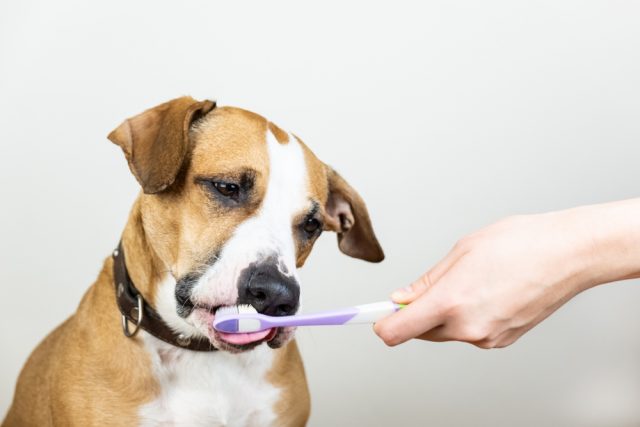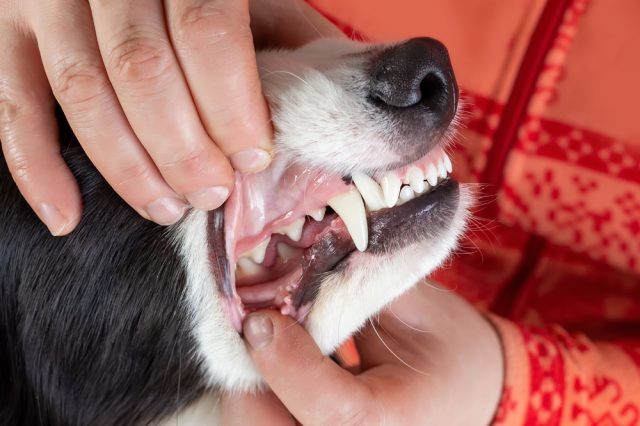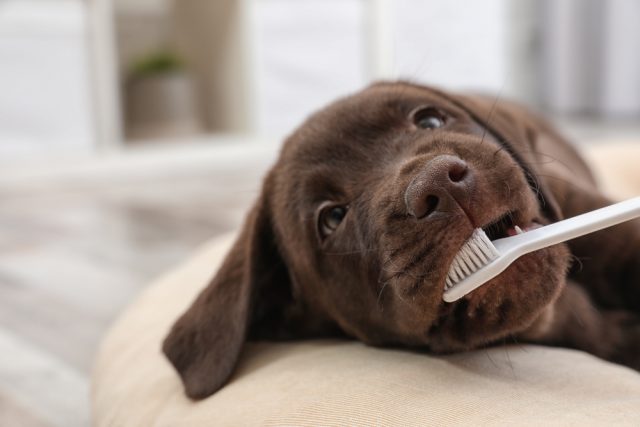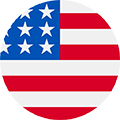Training your puppy to tolerate having their teeth brushed can be quite a challenge, but it is worth the extra effort. Strong, healthy teeth are an essential part of a dog’s health. With training, your pup will grow into a patient, well-behaved dog that calmly endures – or even enjoys – their dental care routine.
Have an older dog? These tips will help you get them used to the teeth-brushing process, too!
Choose A Toothbrush
Like with people, there are several types of toothbrushes you can buy. When picking one out, there are a few things to think about:
- Size of your puppy’s mouth – you need to be able to get to those far back teeth, so the brush head needs to be small enough to fit back there somewhat comfortably.
- Finger brushes – Only use these if your puppy has already learned bite inhibition. Otherwise, you may be reinforcing bad habits when your dog bites on your finger in the brush, then gets rewarded with yummy toothpaste.
- Electric toothbrushes–Just like with humans, electric toothbrushes clean better, but you will have to get your puppy used to the noise and feel of them.
Toothpaste
Buy a few flavors of toothpaste so you can figure out which one is most pleasing to your dog. If he likes the taste, it will make things a lot easier.
They usually come in a peanut butter, mint, and chicken flavor. Remember to check the ingredients and look for anything your dog is allergic to. I prefer all-natural toothpaste, but definitely ask your vet about options and what would be good for your puppy’s (or dog’s) teeth.
Handling The Mouth
To start, you are going to have to get your puppy used to having his face and mouth handled while he is semi-restrained.
Do this by gently touching your puppy and rewarding him for not reacting (biting, pulling away, etc). If he does react, don’t force or correct him. This just means he is not comfortable with the way you are handling him and you need to go slower.
Going slower means figuring out where you can touch your dog without a reaction and start by rewarding him, then slowly build up to touching him where you want with no reaction.
For example, let’s say your dog is fine when you reach toward his mouth with your hand about 6-inches from his body. Any closer than that, however, and he moves away. So, start at that 6-inch mark and reward him for standing still. Then try to move your hand a bit, say to 5.5-inches, and see if your dog is okay. If so, reward. If not, try a smaller increment. You are desensitizing your dog to your touch and for some puppies, this can take a while.
Work on:
- Holding him lightly in place (Tucking under an arm is a good hold)
- Lifting up his upper lips
- Gently opening his mouth
Brushing The Teeth
When he is comfortable with this, it’s time to introduce the toothbrush. Show it to your puppy and look for signs of nervousness. If necessary, use treats to get him used to it. Most dogs, however, are used to having toys in their mouth and don’t mind chewing on a brush!
If you are using an electric toothbrush, hold it away from your puppy and turn it on. If he doesn’t react to the noise, reward. If he does, you may have to muffle it somehow or move farther away to start – it’s the same principle as the handling desensitization explained above.
Now, follow these steps:
- Put a small amount of toothpaste on the brush head and hold it out for your puppy to sniff and hopefully lick, to see if he likes it. If you are using an electric toothbrush, keep it turned off at this point. If he liked it, great. If not, try a different flavor.
- Place your puppy under your arm and hold gently if he is really wiggly (you don’t want him to get excited and bounce around; you may end up jabbing him in the eye with the brush).
- Gently lift his lips and brush the front teeth very gently for just a few seconds, then praise and release him for some petting, play, etc.
- Then you can repeat, gradually working your way to the back teeth. Be sure to keep taking breaks. Stop altogether if your puppy seems too stressed.
It’s okay if he chews on the brush – it helps clean those teeth!
Do this every day, and your dog will have no qualms about getting his teeth brushed, which can save your pup from the pain and health problems associated with dental disease.




